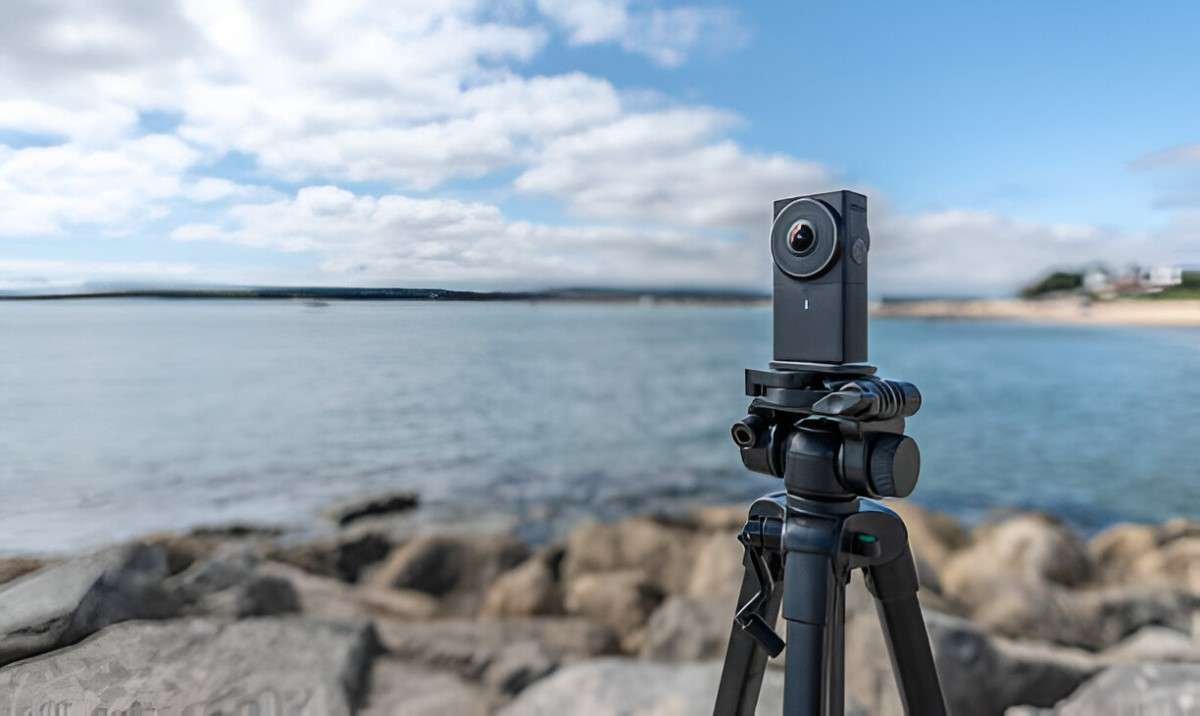360-degree cameras have made it easier than ever to capture immersive content. Whether you want to record scenic landscapes, create VR videos, or just snap unique photos, these cameras offer a versatile approach to photography and videography. But with so many options on the market, how do you choose the right one? In this guide, I’ll walk you through the key factors to consider when buying a 360-degree camera, compare popular models, and help you find the best camera for your needs.
Table of Contents
What is a 360-Degree Camera?
A 360-degree camera is a device that captures an entire scene, providing a full panoramic view. These cameras use multiple lenses or sensors to record footage from all directions simultaneously, creating a complete 360-degree image or video. Unlike traditional cameras that capture only a portion of the scene, 360-degree cameras provide a more immersive experience that can be used for virtual reality (VR), interactive videos, or just cool, all-around photos.
Key Features to Consider
Before diving into specific models, it’s important to understand the key features that make a 360-degree camera stand out. These are the factors I always consider when buying one:
1. Resolution
The resolution of a 360-degree camera is crucial for image clarity. Higher resolution results in sharper images and videos, especially when viewed in VR. Most models today offer at least 4K resolution, but some higher-end options go up to 8K. Keep in mind that 360-degree cameras often use multiple lenses, so the effective resolution might be lower than the total of all the sensors.
2. Stitching Quality
One of the unique challenges of 360-degree cameras is stitching. Since these cameras capture footage from multiple lenses, the images need to be “stitched” together in post-processing. If the stitching isn’t seamless, it can create visible lines or distortions in the footage. Look for cameras that offer advanced stitching technology or real-time stitching, which improves the overall experience.
3. Stabilization
Capturing smooth footage is especially important in 360-degree cameras. Look for a camera that includes built-in image stabilization to minimize shakiness and jarring movements. Electronic Image Stabilization (EIS) is commonly found in many models, and some high-end cameras even offer gimbal-like stabilization.
4. Field of View
A wide field of view is essential for creating immersive 360-degree content. The more lenses a camera has, the wider the field of view, but this can also lead to more complex stitching challenges. Most 360-degree cameras have a field of view that covers 180 to 360 degrees, so you’ll want to find one that offers the right balance for your needs.
5. Battery Life
Battery life can vary significantly depending on the camera’s features and usage. Higher resolution and more advanced features, like live streaming, can drain the battery faster. A typical 360-degree camera will last between one and two hours, but you may want to look for models with longer battery life or the ability to swap out batteries for longer sessions.
6. Size and Portability
Many 360-degree cameras are small and lightweight, making them easy to take with you on the go. If portability is important, make sure to check the weight and size of the camera. Some cameras are designed to fit in your pocket, while others are bulkier and more suited to professional shoots.
7. Connectivity
For easy sharing, connectivity options like Wi-Fi, Bluetooth, and USB ports are important. Some cameras also offer live streaming capabilities, which can be a big plus if you want to broadcast your 360-degree content online. I always check if the camera supports apps for seamless integration with my smartphone or tablet.
Top 360-Degree Cameras to Consider
Now that I’ve covered the key features, let’s dive into some of the best 360-degree cameras available in 2025. To help you make an informed decision, I’ve created a comparison table below, summarizing the top models, their features, and their pros and cons.
Comparison Table: Best 360-Degree Cameras of 2025
| Camera Model | Resolution | Stabilization | Battery Life | Field of View | Special Features | Price (USD) |
|---|---|---|---|---|---|---|
| Insta360 ONE X2 | 5.7K | FlowState EIS | 80 minutes | 360 degrees | Waterproof, touch screen, AI editing | $429 |
| GoPro MAX | 5.6K | Max HyperSmooth | 90 minutes | 360 degrees | Live streaming, rugged design | $499 |
| Ricoh Theta Z1 | 4K | No stabilization (manual) | 60 minutes | 360 degrees | RAW photos, great for professionals | $999 |
| Vuze XR | 5.7K | 3D stabilization | 80 minutes | 180 degrees (stereo), 360 degrees (mono) | 3D 360-degree videos | $499 |
| Xiaomi Mi Sphere | 3.5K | EIS | 75 minutes | 360 degrees | Compact design, affordable | $249 |
| Kandao QooCam 8K | 8K | EIS | 90 minutes | 360 degrees | 8K resolution, great for VR | $649 |
1. Insta360 ONE X2
The Insta360 ONE X2 is one of the most popular 360-degree cameras out there, and for good reason. It offers 5.7K resolution, ensuring that your videos and images come out crisp and clear. The FlowState Electronic Image Stabilization (EIS) makes sure that even the shakiest footage is smooth. What I particularly like about the ONE X2 is its waterproof design, making it perfect for outdoor adventures. It also offers intuitive mobile app controls and AI-based editing tools, so even beginners can create impressive content.
Pros:
- High-quality resolution
- Waterproof and rugged
- AI-powered editing features
- Compact and easy to use
Cons:
- Lower battery life compared to other models
- Stitching can be noticeable in challenging lighting conditions
2. GoPro MAX
The GoPro MAX offers fantastic stabilization with its Max HyperSmooth feature, ensuring steady footage even in the most dynamic environments. It’s a favorite among action sports enthusiasts because of its durability and performance in harsh conditions. Additionally, it offers live streaming capabilities, which makes it a great choice for sharing real-time 360-degree content with friends, followers, or clients. Its battery life is solid, and the camera is very user-friendly.
Pros:
- Excellent stabilization
- Live streaming capability
- Durable and waterproof
- Great for action shots
Cons:
- The resolution is slightly lower than some competitors
- The user interface can be a bit tricky for first-time users
3. Ricoh Theta Z1
For those who need professional-grade 360-degree images, the Ricoh Theta Z1 is one of the best choices. It features a large 1-inch sensor that captures superior low-light performance and rich detail. The downside is that it doesn’t offer built-in stabilization, which means it’s more suitable for tripod-based setups or controlled shooting environments. If you’re serious about 360-degree photography, this is a top-tier option.
Pros:
- Outstanding image quality, especially in low light
- RAW photo support for advanced editing
- Compact design
Cons:
- No built-in stabilization
- Higher price point
4. Vuze XR
The Vuze XR is a versatile camera that lets you switch between 180-degree 3D and 360-degree modes. This flexibility makes it a great choice for people who want to experiment with different types of content. It’s not quite as compact as some of the other cameras, but it offers excellent 3D recording capabilities, which is unique in the 360-degree camera market.
Pros:
- 3D 360-degree content
- Flexible shooting modes
- Good stabilization
Cons:
- Bulky design
- Stitching isn’t as seamless as other models
5. Xiaomi Mi Sphere
The Xiaomi Mi Sphere is an affordable option that still delivers great performance. It’s a more budget-friendly choice, but it still offers 360-degree video at 3.5K resolution, making it a great starting point for those who want to try out 360-degree cameras without breaking the bank. While the image quality might not be on par with higher-end models, it’s more than enough for casual use.
Pros:
- Affordable
- Compact and easy to carry
- Decent image quality for its price
Cons:
- Limited resolution compared to competitors
- Stitching can be noticeable in certain lighting conditions
6. Kandao QooCam 8K
The Kandao QooCam 8K is a top-of-the-line camera for those who want the best resolution available. With an 8K resolution, it’s perfect for creating VR content or anything that requires extreme detail. It’s also equipped with built-in EIS to reduce shakiness, making it a great choice for both professionals and enthusiasts alike.
Pros:
- 8K resolution
- Excellent for VR and high-definition projects
- Great stabilization
Cons:
- Expensive
- Not as portable as other models
Conclusion: Finding the Best 360-Degree Camera
When it comes to choosing the best 360-degree camera, there’s no one-size-fits-all solution. It really depends on what you plan to do with your footage. If you’re a casual user looking for something easy to use, a model like the Xiaomi Mi Sphere or Insta360 ONE X2 might be perfect. If you’re a professional who needs high-quality images or specialized features like 3D content or 8K video, cameras like the Ricoh Theta Z1 or Kandao QooCam 8K will give you the best results.
Ultimately, the best 360-degree camera for you is the one that fits your needs and budget. By considering factors like resolution, stabilization, and connectivity, you can make an informed decision and start creating immersive content in no time.





